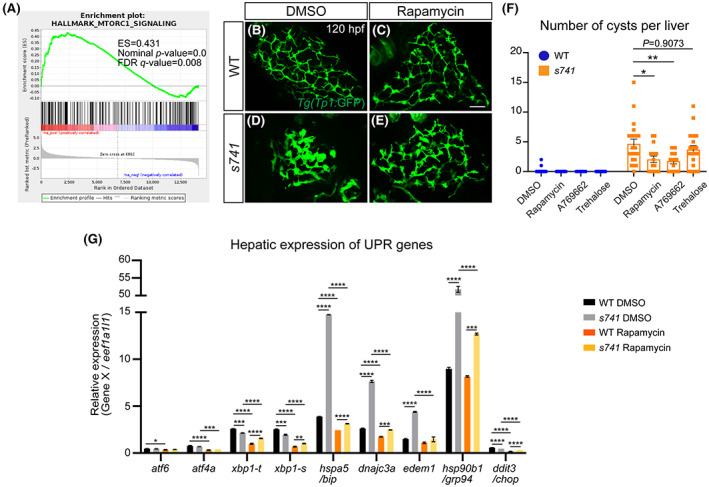Fig. 7
Rapamycin treatment reduces the number of hepatic cysts in s741 mutants. (A) GSEA plot shows a significant enrichment of mammalian target of rapamycin complex 1 (mTORC1) signaling in s741 mutant livers. (B–E) Confocal 3D projections of Tg(Tp1:GFP)+ biliary cells after DMSO or 5 μmol/L rapamycin treatment from 72 hpf to 120 hpf. Ventral views; anterior is on the top. Scale bar: 30 μm. (F) Numbers (mean ± SEM) of liver cysts after chemical treatments. Each point represents an individual liver. (G) Quantitative real‐time PCR analyses showing the hepatic expression of UPR response genes in WT and s741 mutants after DMSO or rapamycin treatment from 72 hpf to 120 hpf. Triplicates were performed. The results are represented as relative expression normalized to the housekeeping gene eef1a1l1 (mean ± SEM). Statistical significance in (F) and (G) was calculated by one‐way ANOVA and Tukey's post‐hoc test: *p < 0.05; **p < 0.01; ***p < 0.001; ****p < 0.0001. atf6, activating transcription factor 6; atf4a, activating transcription factor 4a; xbp1‐t, x‐box binding protein 1‐total; xbp1‐s: x‐box binding protein 1‐splicing; hspa5/bip: heat shock protein family A (Hsp70) member 5; dnajc3a: Dnaj (Hsp40) homolog, subfamily C, member 3a; edem1: ER degradation enhancing α‐mannosidase like protein 1; hsp90b1/grp94: heat shock protein 90 β family member 1; ddit3/chop: DNA damage inducible transcript 3.

